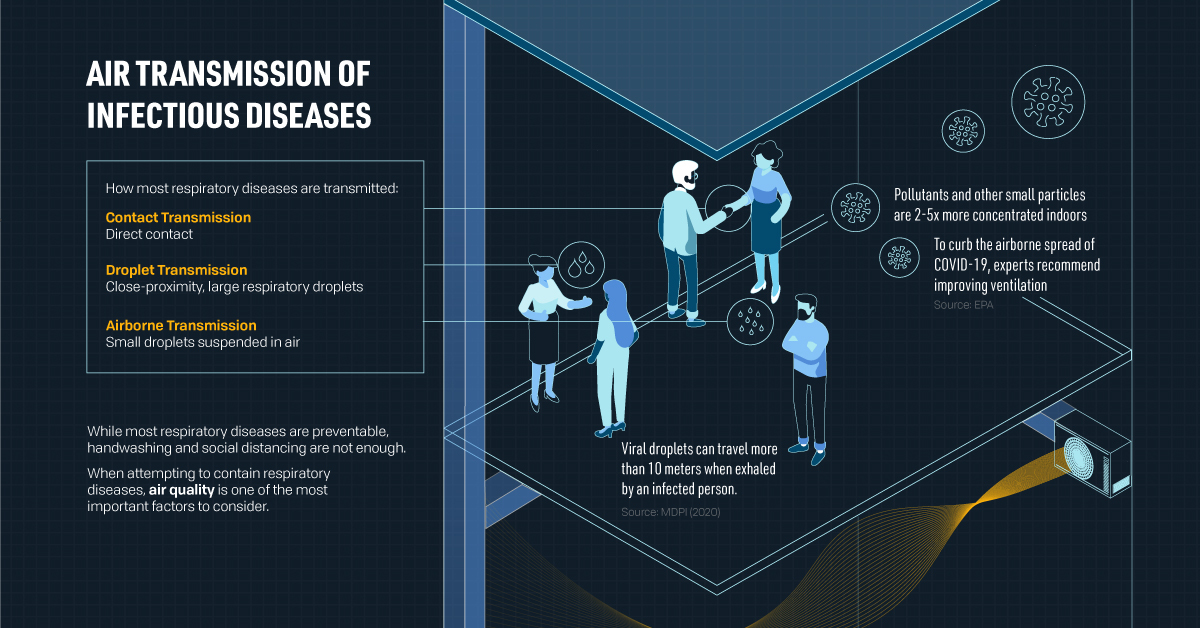Safe Spaces: Why Indoor Air Quality Has Never Mattered More
The following content is sponsored by mCloud.

Why Indoor Air Quality Has Never Mattered More
Indoor air quality affects everyone, but many of us take it for granted.
From workplaces and retail spaces to restaurants and long-term care facilities, any air-conditioned or heated space needs good ventilation. Proper airflow in indoor spaces is also critical for curbing the spread of airborne viruses such as COVID-19, especially as more and more of these communal places open back up.
This visualization from mCloud looks at why indoor air quality matters, and unearths potential technical solutions that can help keep people safe and ensure businesses run smoothly.
Silent Threats: The Viral Potential of Airborne Viruses
Most respiratory diseases, including the flu virus and COVID-19 are transmitted through three typical methods.
- Contact Transmission
Through direct contact - Droplet Transmission
Through close-proximity, large respiratory droplets - Airborne Transmission
Through small droplets suspended in air
It’s this last factor in particular to keep an eye out for. In a study, over half (53%) of flu patients produced aerosol particles of the virus while coughing—and viral droplets can travel more than 10 meters when exhaled by an infected person. In addition, pollutants and other small particles are 2-5x more concentrated indoors.
While most respiratory diseases are preventable, it’s clear that handwashing and social distancing are not enough. Alongside other measures, experts recommend improved ventilation to help prevent the spread of COVID-19 in indoor spaces.
Avoid Sick Building Syndrome with Good Indoor Air Quality
Prior to the pandemic, 157 million people in the U.S. workforce spent the majority of their waking hours in shared areas like offices, stores, and more. In fact, there are 5.9 million commercial buildings in the U.S. alone, totaling 97 billion ft².
Within these indoor spaces, heating, ventilation, and air-conditioning (HVAC) systems help to keep the air fresh. But have you ever gone to work and realized that there’s a flu bug that everyone seems to be catching? Poor air flow could be the culprit behind what’s called “Sick Building Syndrome”.
Example: A movie theater with a 100-person capacity would require 500 cubic feet of air cycled per minute to maintain adequate fresh airflow.
Most buildings are designed to recirculate air to boost energy efficiency. However, this doesn’t always occur evenly—causing air to stagnate.
If what should be fresh air becomes stagnant air instead, this can result in the distribution of allergens and pathogens, including COVID-19 and the flu. Symptoms of Sick Building Syndrome include:
- Itchy, watery eyes
- Stuffy, runny nose
- Lethargy
- Cognitive issues
- Headache
- Dry throat
- Skin irritation
Studies show that air-conditioned buildings exhibit a higher prevalence of workers with these symptoms compared to naturally ventilated buildings. Many different types of buildings are at risk—although air is replaced in operating rooms every 3-6 minutes, it is only replaced every few hours in office buildings.
Proven Solutions to Keep Spaces Safe
Indoor air quality has a significant impact on containing respiratory diseases, including COVID-19. In fact, proper air ventilation can have the same impact as vaccinating 50-60% of people in a building.
mCloud partners with businesses to help augment their technical needs, and help manage workplace challenges associated with indoor health risks.
| Workplace Challenges | mCloud’s Strategies |
|---|---|
| Aerosol transmission is a main contributor to respiratory illnesses | Use technical solutions that include constant monitoring |
| Improved airflow is critical to reopening infrastructure and ramping up operations | Improve humidity levels: spikes in respiratory infections occur when humidity drops below 40% |
| Solutions must be cost-efficient, but measuring and improving indoor air quality is extremely difficult | Improve indoor air quality with ventilation and filtration technology |
Semiconductor-grade cleanrooms—filtered, controlled environments—improve HVAC systems, allowing for remote monitoring, and temperature and humidity control.
How do mCloud’s solutions help improve indoor air quality?
- HVAC & Ventilation
Full ventilation that maximizes influx of outside air - Filtration & Purification
Ionization and ultraviolet light can capture and kill up to 99.9% of viruses, including COVID-19 - Monitoring
Real-time monitoring by an expert team, with 24/7 monitoring - 24/7 Compliance
Businesses ensure they meet local and federal safety guidelines
Combining connectivity with air purification can improve HVAC systems, allowing for remote monitoring, temperature and humidity control. This can result in a 95% reduction in airborne particles (compared to standard filtration in operating rooms), and could have a 95% pathogen kill rate within just three hours.
As a myriad of shared places from offices to retail stores reopen, physical safety and health is a top priority for employers. Businesses can partner with experts to create healthy, safe spaces that protect people, companies, and entire industries.
-

 Sponsored3 years ago
Sponsored3 years agoMore Than Precious: Silver’s Role in the New Energy Era (Part 3 of 3)
Long known as a precious metal, silver in solar and EV technologies will redefine its role and importance to a greener economy.
-

 Sponsored7 years ago
Sponsored7 years agoThe History and Evolution of the Video Games Market
Everything from Pong to the rise of mobile gaming and AR/VR. Learn about the $100 billion video games market in this giant infographic.
-

 Sponsored8 years ago
Sponsored8 years agoThe Extraordinary Raw Materials in an iPhone 6s
Over 700 million iPhones have now been sold, but the iPhone would not exist if it were not for the raw materials that make the technology...
-

 Sponsored8 years ago
Sponsored8 years agoThe Industrial Internet, and How It’s Revolutionizing Mining
The convergence of the global industrial sector with big data and the internet of things, or the Industrial Internet, will revolutionize how mining works.


